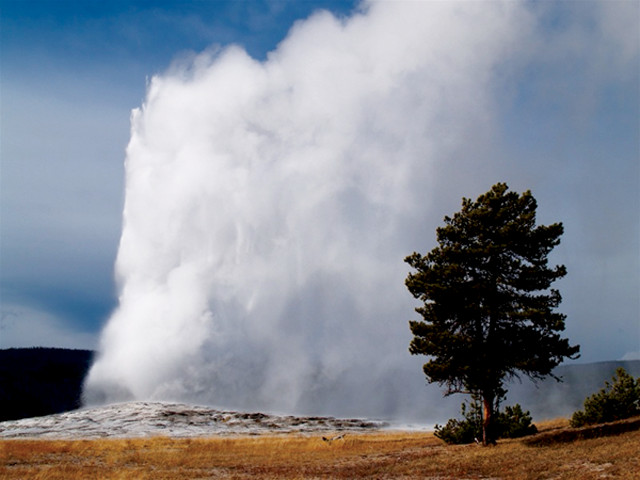
by Mary Caperton Morton Wednesday, July 19, 2017

Old Faithful's hourly eruptions can usually be predicted to within a 10-minute window. Credit: Mary Caperton Morton.
The Old Faithful geyser in Yellowstone National Park has erupted predictably within a 10-minute window every hour for more than 150 years, but the inner workings that power its regular 30-meter-high eruptive plumes are largely still a mystery. Recent monitoring of the gusher is revealing new secrets about its plumbing system, which may help the National Park Service plan for future infrastructure expansions around the popular attraction.
Jamie Farrell, of the University of Utah, and colleagues deployed hundreds of seismometers around the geyser, leaving the instruments to continuously record data over roughly two-week periods in both November 2015 and November 2016. The instruments picked up signals of underground tremors, which begin building about 45 minutes before each blast, peak about 25 minutes beforehand, and then slowly die down until the heated water and steam eruption begins. The small tremors are thought to be caused by hydrothermal bubbling in Old Faithful’s subsurface plumbing system, Farrell reported at the Seismological Society of America’s annual meeting in Denver in April.
The team’s data painted a picture of how the hydrothermal features under the geyser work, including “what these geothermal structures look like under the ground, what’s happening underground when they’re getting ready for an eruption, and how these things are related to each other and how they react to outside stresses, even earthquakes from around the world,” Farrell said in a statement.
Farrell’s team also observed the shape of the underground water reservoir that supplies the water expelled in the geyser’s eruptions. Seismic signals don’t travel well through fluids, so the lack of signal from the instruments west and northwest of the geyser suggests that the ground there is saturated with hydrothermal fluids, Farrell explained. “We think that’s telling us that we have this shallow, very saturated body of ground there, and it’s probably the reservoir [from which] Old Faithful is pulling water,” he said.
Data collection in the study was confined to the period between the fall closure of most of Yellowstone’s facilities and the onset of deep winter, a period when the footfalls of thousands of visitors a day wouldn’t interfere with the seismic instruments. The project may help park planners protect Old Faithful and its delicate plumbing from future renovations or expansions of the boardwalk and facilities around the geyser.
A better understanding of the seismic patterns leading up to Old Faithful’s eruptions may also help scientists predict eruption times for other, less-faithful geysers, such as Yellowstone’s Steamboat Geyser, the tallest active geyser in the world, which can be quiet for days to years between 100-meter-tall eruptions.
© 2008-2021. All rights reserved. Any copying, redistribution or retransmission of any of the contents of this service without the expressed written permission of the American Geosciences Institute is expressly prohibited. Click here for all copyright requests.